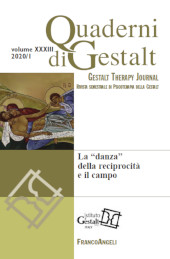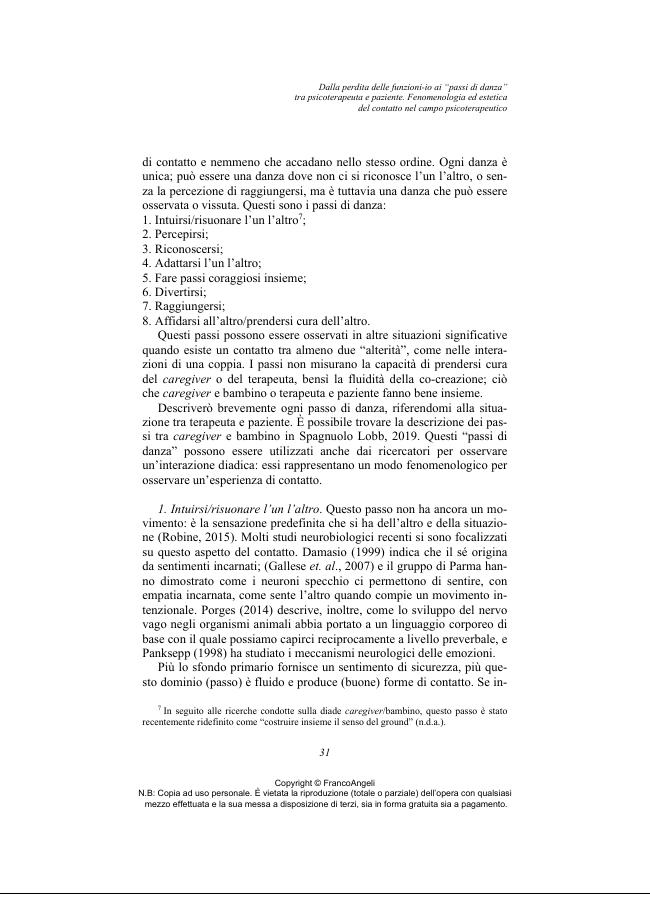Dalla perdita delle funzioni-io ai "passi di danza" tra psicoterapeuta e paziente : fenomenologia ed estetica del contatto nel campo psicoterapeutico
21-40 p.
Questo articolo si propone di descrivere il processo di contatto tra paziente e terapeuta come una danza co-creata. La finalità è quella di superare il linguaggio individualistico ancora presente nelle categorie di Gestalt Therapy (Perls et al., 1951), come dimostrato nel termine "perdita delle funzioni-io", utilizzando l'idea della danza, che comprende i sentimenti e i movimenti sia del terapeuta che del paziente. Questa prospettiva è in linea con gli studi contempo-ranei delle neuroscienze, gli approcci intersoggettivi e la psicoanalisi relazionale; permette inoltre al terapeuta di rimanere con la spontaneità della co-creazione del contatto terapeutico (i "passi di danza"), e allo stesso tempo di includere aspetti evolutivi e psicopatologici dell'esperienza (lo sviluppo polifonico dei domini) come parte dell'esperienza dello sfondo, come una "musica dei passi" che il paziente compie nella situazione terapeutica. [Testo dell'editore].
This paper tries to describe the actual contact-making between client and therapist as a co-created "dance". It basically makes a proposal to get rid of the individualistic language that is still in Gestalt therapy's categories called "losses of ego functions", by using the idea of dance, which includes the feelings and the movements of both therapist and client. The author under-lines the need to develop the concepts of the original formulation by Perls, Hefferline and Goodman (1951; 1994, pp. 235 ff.) into categories which consider the mutual interactions be-tween two people. This perspective is in line with contemporary studies of neurosciences (just as an example: Damasio, 1999; Siegel, 1999; Gallese et al., 2007), intersubjective and rela-tional psychoanalysis (Mitchell, 2000; Stern et al., 2003). Describing her concept of Aesthetic Relational Knowledge (Spagnuolo Lobb, 2018), the author shows how the therapist feels part of the experiential field co-created with the client.
The therapist uses her own attunement and resonance with a field-oriented, phenomenological and aesthetic glance. This perspective al-lows the therapist to stay with the spontaneity of the co-creation of the therapeutic contact (the "dance steps"), including at the same time developmental and psychopathological aspects of the experience of the client (the polyphonic development of domains). These make the client's experience of the ground, as a "music of steps" that the client plays in the therapeutic session.
She also presents a grid that summarises the excitement experienced at the boundary, vital competences and risks of each "dance step". This tool can be used by therapists, to orient their work, and for training, supervision and research purposes. Considering different kinds of "music" in the experience of the ground, this work is based on the humanistic idea that any suffering is also a competence for contact and that change comes from staying with it, instead of from external interventions. This paper is also based on the aesthetic idea that there is a harmony in the way we perceive the world, however we per-ceive it - whether with anxiety and pain or with full senses and joy. Rather than paying atten-tion to what does not work, the author underlines the importance of recognizing this beauty in clients, using the therapist's own presence as a field-oriented tool. [Publisher's text].
-
Artikel aus derselben Ausgabe (einzeln erhältlich)
-
Informationen
ISSN: 2035-6994
THEMENBEREICHE
KEYWORDS
- Passi di danza, conoscenza relazionale estetica, campo, reciprocità, sviluppo polifonico dei domini
- Dance steps, aesthetic relational knowledge, field, losses of ego functions, polyphonic devel-opment of domains



